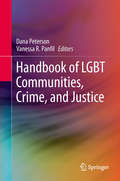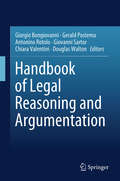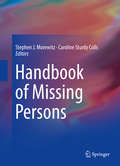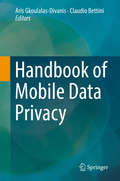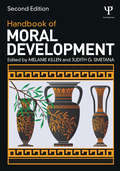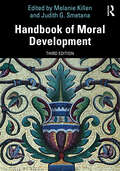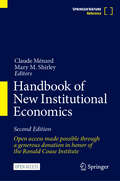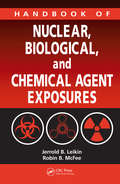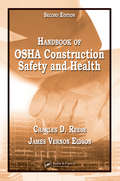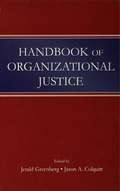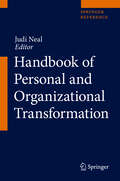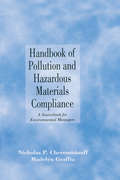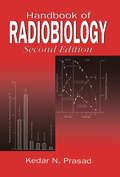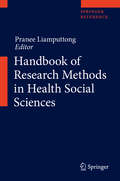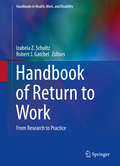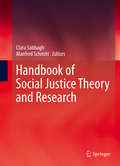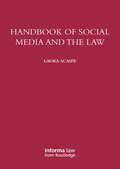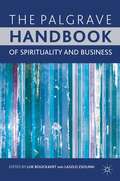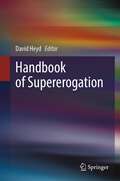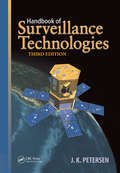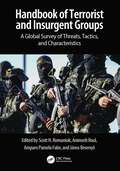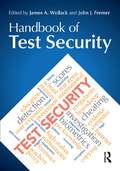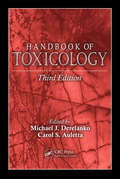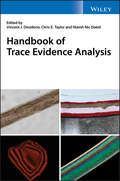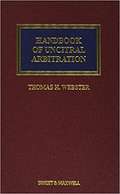- Table View
- List View
Handbook of LGBT Communities, Crime, and Justice
by Dana Peterson Vanessa R. PanfilContemporary scholars have begun to explore non-normative sexual orientation, gender identity, and gender expression in a growing victimization literature, but very little research is focused on LGBTQ communities' patterns of offending (beyond sex work) and their experiences with police, the courts, and correctional institutions. This Handbook, the first of its kind in Criminology and Criminal Justice, will break new ground by presenting a thorough treatment of all of these under-explored issues in one interdisciplinary volume that features current empirical work.
Handbook of Legal Reasoning and Argumentation
by Douglas Walton Giovanni Sartor Antonino Rotolo Giorgio Bongiovanni Gerald Postema Chiara ValentiniThis handbook addresses legal reasoning and argumentation from a logical, philosophical and legal perspective. The main forms of legal reasoning and argumentation are covered in an exhaustive and critical fashion, and are analysed in connection with more general types (and problems) of reasoning. Accordingly, the subject matter of the handbook divides in three parts. The first one introduces and discusses the basic concepts of practical reasoning. The second one discusses the general structures and procedures of reasoning and argumentation that are relevant to legal discourse. The third one looks at their instantiations and developments of these aspects of argumentation as they are put to work in the law, in different areas and applications of legal reasoning.
Handbook of Missing Persons
by Caroline Sturdy Colls Stephen J. MorewitzThis ambitious multidisciplinary volume surveys the science, forensics, politics, and ethics involved in responding to missing persons cases. International experts across the physical and social sciences offer data, case examples, and insights on best practices, new methods, and emerging specialties that may be employed in investigations. Topics such as secondary victimization, privacy issues, DNA identification, and the challenges of finding victims of war and genocide highlight the uncertainties and complexities surrounding these cases as well as possibilities for location and recovery. This diverse presentation will assist professionals in accessing new ideas, collaborating with colleagues, and handling missing persons cases with greater efficiency--and potentially greater certainty. Among the Handbook's topics: #65533;A profile of missing persons: some key findings for police officers. #65533;Missing persons investigations and identification: issues of scale, infrastructure, and political will. #65533;Pregnancy and parenting among runaway and homeless young women. #65533;Estimating the appearance of the missing: forensic age progression in the search for missing persons. #65533;The use of trace evidence in missing persons investigations. #65533;The Investigation of historic missing persons cases: genocide and "conflict time" human rights abuses. The depth and scope of its expertise make the Handbook of Missing Persons useful for criminal justice and forensic professionals, health care and mental health professionals, social scientists, legal professionals, policy leaders, community leaders, and military personnel, as well as for the general public.
Handbook of Mobile Data Privacy
by Aris Gkoulalas-Divanis Claudio BettiniThis handbook covers the fundamental principles and theory, and the state-of-the-art research, systems and applications, in the area of mobility data privacy. It is primarily addressed to computer science and statistics researchers and educators, who are interested in topics related to mobility privacy. This handbook will also be valuable to industry developers, as it explains the state-of-the-art algorithms for offering privacy. By discussing a wide range of privacy techniques, providing in-depth coverage of the most important ones, and highlighting promising avenues for future research, this handbook also aims at attracting computer science and statistics students to this interesting field of research. The advances in mobile devices and positioning technologies, together with the progress in spatiotemporal database research, have made possible the tracking of mobile devices (and their human companions) at very high accuracy, while supporting the efficient storage of mobility data in data warehouses, which this handbook illustrates. This has provided the means to collect, store and process mobility data of an unprecedented quantity, quality and timeliness. As ubiquitous computing pervades our society, user mobility data represents a very useful but also extremely sensitive source of information. On one hand, the movement traces that are left behind by the mobile devices of the users can be very useful in a wide spectrum of applications such as urban planning, traffic engineering, and environmental pollution management. On the other hand, the disclosure of mobility data to third parties may severely jeopardize the privacy of the users whose movement is recorded, leading to abuse scenarios such as user tailing and profiling. A significant amount of research work has been conducted in the last 15 years in the area of mobility data privacy and important research directions, such as privacy-preserving mobility data management, privacy in location sensing technologies and location-based services, privacy in vehicular communication networks, privacy in location-based social networks, privacy in participatory sensing systems which this handbook addresses.. This handbook also identifies important privacy gaps in the use of mobility data and has resulted to the adoption of international laws for location privacy protection (e.g., in EU, US, Canada, Australia, New Zealand, Japan, Singapore), as well as to a large number of interesting technologies for privacy-protecting mobility data, some of which have been made available through open-source systems and featured in real-world applications.
Handbook of Moral Development
by Judith G. Smetana Melanie KillenThe Handbook of Moral Development is the definitive source of theory and research on the development of morality. Since the publication of the first edition, ground-breaking approaches to studying the development of morality have re-invigorated debates about what it means to conceptualize and measure morality in early childhood, how children understand fairness and equality, what the evolutionary basis is for morality, and the role of culture. The contributors of this new edition grapple with these questions and provide answers for how morality originates, changes, evolves, and develops during childhood, adolescence, and into adulthood. Thoroughly updated and expanded, the second edition features new chapters that focus on: infancy neuroscience theory of mind moral personality and identity cooperation and culture gender, sexuality, prejudice and discrimination Reflecting the interdisciplinary nature of the study of moral development, this edition contains contributions from over 50 scholars in developmental science, cognitive psychology, social neuroscience, comparative psychology and evolution, and education.
Handbook of Moral Development
by Judith G. Smetana Melanie KillenThe Handbook of Moral Development is the definitive source of theory and research on the origins and development of morality in childhood and adolescence. It explores morality as fundamental to being human and enabling individuals to acquire social norms and develop social relationships that involve cooperation and mutual respect. Since the publication of the second edition, groundbreaking approaches to studying moral development have invigorated debates about how to conceptualize and measure morality in childhood and adolescence. The contributors of this new edition grapple with these questions from different theoretical perspectives and review cutting-edge research. The handbook, edited by Melanie Killen and Judith G. Smetana, includes chapters on parenting and socialization, values, emergence of prejudice and social exclusion, fairness and access to resources, moral reasoning and children’s rights, empathy, and prosocial behaviors. Morality is discussed in the context of families, peers, schools, and culture. Thoroughly updated and expanded, the third edition features new chapters on the following: • Morality in infancy and early childhood • Cognitive neuroscience perspectives on moral development • Social responsibility in the context of social and racial justice • Conceptions of economic and societal inequalities • Stereotypes, bias, and discrimination • Victimization and bullying in peer contexts Reflecting the interdisciplinary nature of the study of moral development, this edition contains contributions from sixty scholars in developmental science, social neuroscience, comparative and evolutionary psychology, and education, representing research conducted around the world. This book will be essential reading for scholars, educators, and students who are in the field of moral development, as well as social scientists, public health experts, and clinicians who are concerned with children and development.
Handbook of New Institutional Economics
by Claude Ménard Mary M. ShirleyThis Open Access Handbook of New Institutional Economics (NIE) is a comprehensive reference work providing a unique and timely overview of recent developments and broad orientations in institutional analysis. This second edition has been thoroughly updated and extended, including 23 new chapters on political and legal institutions, organizations and contracts, regulation, culture, methodology and institutional change. Chapters have been written by highly respected scientists in the field, among them Ronald Coase, Douglass North, Elinor Ostrom, Oliver Williamson and Roger Myerson, all Nobel recipients, as well as by numerous other foremost NIE specialists at the frontier of NIE research. This Handbook gives students and young researchers an introduction to the topic and offers all scholars a reference book for their research. It will also be of interest to economists, political scientists, legal scholars, management specialists, sociologists, and others wishing to learn more about these important subjects and gain insight into progress made by institutionalists from other disciplines. Open access made possible through a generous donation in honor of the Ronald Coase Institute.
Handbook of Nuclear, Biological, and Chemical Agent Exposures
by Jerrold B. Leikin Robin B. McFeeTreating nuclear, biological, and chemical agent exposures presents a unique set of challenges. These scenarios usually involve multiple exposures, sometimes even mass exposures, from a single, often poorly-defined, event. Early symptoms are not distinct and can often be variable. Laboratory analyses may be required from environmental, often nonbio
Handbook of OSHA Construction Safety and Health
by Charles D. Reese James Vernon EidsonA practical guide for eliminating safety and health hazards from construction worksites, the Handbook of OSHA Construction Safety and Health addresses the occupational safety and health issues faced by those working in the construction industry. The book covers a vast range of issues including program development, safety and health program implemen
Handbook of Organizational Justice
by Jason A. Colquitt Jerald GreenbergMatters of perceived fairness and justice run deep in the workplace. Workers are concerned about being treated fairly by their supervisors; managers generally are interested in treating their direct reports fairly; and everyone is concerned about what happens when these expectations are violated. This exciting new handbook covers the topic of organizational justice, defined as people's perceptions of fairness in organizations.The Handbook of Organizational Justice is designed to be a complete, current, and comprehensive reference chronicling the current state of the organizational justice literature. Tracing the development of ideas regarding organizational justice, this book:*introduces the topic of organizational justice from a historical perspective and presents fundamental issues regarding the nature of organizational justice;*examines the justice judgment process, specifically addressing basic psychological processes, such as the roles of control, self-interest, morality, and trust in the formation of justice judgments;*discusses the consequences of fair and unfair treatment in the workplace;*focuses on such key issues as promoting justice in the workplace in ways that help manage stress, and the underlying processes that account for the effectiveness of justice applications;*examines the generalizability of the interaction between process and outcomes and focuses on the notion of cross-cultural differences in justice effects; and*summarizes the state of the science of organizational justice and presents various issues for future research and theorizing.This Handbook is useful as a guide for professors and graduate students, primarily in the fields of management and psychology. It also is highly relevant to professionals in the fields of communication, sociology, legal studies, marketing, and human resources management.
Handbook of Personal and Organizational Transformation
by Judi NealThis handbook is based on the premise that there can be no organizational transformation without personal transformation. Anything else is just moving the chairs around on the deck of the Titanic, and we see that all too often in organizations today. Einstein said that we cannot solve problems from the same mindset that created the problems. In order to see positive change occur in the world, we must shift our consciousness to a high level of thinking and being, but we must also have systems or approaches that scale up, so that there is a collective shift in consciousness in groups, work teams, villages, governments, and corporations. This handbook aims to draw the best and most creative thinking about the field of transformation in one place, to present a comprehensive overview of leading edge transformation theories and approaches for both the academic and the practitioner. In fact, the lines between academic and practitioner are becoming more and more blurred these days. Many management faculty also consult to organizations, a practice that deeply enriches their teaching and research. And many successful full-time consultants conduct high quality research to support their approaches and change initiatives. This Handbook aims to be a creative dialogue in this space that integrates transformation theory and practice. The Handbook of Personal and Organizational Transformation acknowledges the classic literature and principles that have informed the field to date, but primarily showcases authors who are on the cutting edge of new theories and new approaches to give us their latest thinking. Some of these ideas are conjecture about what is possible in human and organizational development. Some of these approaches are currently being tested in the field and may not yet have scientific results. And some of these theories and models have stunning results, but may not have been published in academic journals because the author is a practitioner instead of an academic, or because the concepts are a little too far out of the mainstream. The aim of this book is to expand the reader’s thinking and to encourage readers to be courageous about their involvement in creating transformation, at whatever level they feel called to do so. It will serve as an essential resource for researchers and students of organizational culture, leadership, and change management, as well as consultants, business and team leaders, and anyone interested in global trends and their impact on corporate culture.
Handbook of Pollution and Hazardous Materials Compliance: A Sourcebook for Environmental Managers (Environmental Science & Pollution)
by Nicholas P. Cheremisinoff Madelyn GraffiaOffers a guide to current environmental health and safety statutes--providing a working knowledge of the major legislations and regulations and demonstrating the steps necessary for compliance. Illustrates overall health and safety management skills for multimedia facilities.
Handbook of Radiobiology
by Kedar N. PrasadThis handbook presents the most current information on the effects of ionizing radiation on mammalian cells, with emphasis on human tissues. The dose-effect relationship is emphasized in a quantitative manner. The book contains up-to-date data on the late effects of low levels of radiation on humans. It also provides some of the late consequences of radiation therapy detected among cancer survivors.
Handbook of Research Methods in Health Social Sciences
by Pranee LiamputtongResearch is defined by the Australian Research Council as “the creation of new knowledge and/or the use of existing knowledge in a new and creative way so as to generate new concepts, methodologies, inventions and understandings”. Research is thus the foundation for knowledge. It produces evidence and informs actions that can provide wider benefit to a society. The knowledge that researchers cultivate from a piece of research can be adopted for social and health programs that can improve the health and well-being of the individuals, their communities and the societies in which they live. As we have witnessed in all corners of the globe, research has become an endeavor that most of us in the health and social sciences cannot avoid. This Handbook is conceived to provide the foundation to readers who wish to embark on a research project in order to form knowledge that they need. The Handbook comprises four main sections: Traditional research methods sciences; Innovative research methods; Doing cross-cultural research; and Sensitive research methodology and approach. This Handbook attests to the diversity and richness of research methods in the health and social sciences. It will benefit many readers, particularly students and researchers who undertake research in health and social science areas. It is also valuable for the training needs of postgraduate students who wish to undertake research in cross-cultural settings, with special groups of people, as it provides essential knowledge not only on the methods of data collection but also salient issues that they need to know if they wish to succeed in their research endeavors.
Handbook of Return to Work
by Izabela Z. Schultz Robert J. GatchelThis comprehensive interdisciplinary synthesis focuses on the clinical and occupational intervention processes enabling workers to return to their jobs and sustain employment after injury or serious illness as well as ideas for improving the wide range of outcomes of entry and re-entry into the workplace. Information is accessible along key theoretical, research, and interventive lines, emphasizing a palette of evidence-informed approaches to return to work and stay at work planning and implementation, in the context of disability prevention. Condition-specific chapters detail best return to work and stay at work practices across diverse medical and psychological diagnoses, from musculoskeletal disorders to cancer, from TBI to PTSD. The resulting collection bridges the gap between research evidence and practice and gives readers necessary information from a range of critical perspectives. Among the featured topics: Understanding motivation to return to work: economy of gains and losses. Overcoming barriers to return to work: behavioral and cultural change. Program evaluation in return to work: an integrative framework. Working with stakeholders in return to work processes. Return to work after major limb loss. Improving work outcomes among cancer survivors. Return to work among women with fibromyalgia and chronic fatigue syndrome. The Handbook of Return to Work is an invaluable, unique and comprehensive resource for health, rehabilitation, clinical, counselling and industrial psychologists, rehabilitation specialists, occupational and physical therapists, family and primary care physicians, psychiatrists and physical medicine and rehabilitation as well as occupational medicine specialists, case and disability managers and human resource professionals. Academics and researchers across these fields will also find expert guidance and direction in these pages. It is an essential reading for all return to work and stay at work stakeholders.
Handbook of Social Justice Theory and Research
by Clara Sabbagh Manfred SchmittThe International Society for Justice Research (ISJR) aims to provide a platform for interdisciplinary justice scholars who are encouraged to present and exchange their ideas. This exchange has yielded a fruitful advance of theoretical and empirically-oriented justice research. This volume substantiates this academic legacy and the research prospects of the ISJR in the field of justice theory and research. Included are themes and topics such as the theory of the justice motive, the mapping of the multifaceted forms of justice (distributive, procedural) and justice in context-bound spheres (e. g. non-humans). It presents a comprehensive "state of the art" overview in the field of justice research theory and it puts forth an agenda for future interdisciplinary and international justice research. It is worth noting that authors in this proposed volume represent ISJR's leading scholarship. Thus, the compilation of their research within a single framework exposes potential readers to high quality academic work that embodies the past, current and future trends of justice research.
Handbook of Social Media and the Law
by Laura ScaifeBillions of minutes a month are spent globally on social media. This raises not only serious legal issues, but also has a clear impact on everyday commercial activity. This book considers the significant legal developments that have arisen due to social media. It provides an expert explanation of the issues that practitioners and businesses need to consider, as well as the special measures that are required in order to minimise their exposure to risk. The content is highly practical, and not only explores the law related to social media, but also includes useful aids for the reader, such as flow charts, checklists and case studies. Various categories and channels of social media are covered in this book, alongside the legal classification of different social networks. Social media is also considered in the context of human rights law by evaluating the implications this has had upon the development of civil and criminal law when pursuing a civil remedy or criminal prosecution in relation to online speech. As part of these discussions the book deals specifically with the Defamation Act 2013, the Communications Act 2003, the Computer Misuse Act 1990 and the Contempt of Court Act 1988 among other key issues such as seeking Injunctions and the resulting privacy implications. Finally, the author also pays careful consideration to the commercial aspects raised by social media. The reader will find reference to key cases and regulatory guidance notes and statutes including, the Data Protection Act 1998 (including the draft Data Protection Regulation), user privacy, human rights, trading and advertising standards, special rules for FCA regulated bodies and social media insurance. This book is an invaluable guide for private practice and in-house practitioners, business professionals, academics and post-graduate students involved in the law surrounding social media.
Handbook of Spirituality and Business
by Laszlo Zsolnai Luk BouckaertA summary of the most important issues, approaches and models in the field of spirituality in business, economics and society. The Handbook of Spirituality and Business presents a comprehensive pluralistic view covering all the major religious and spiritual traditions.
Handbook of Supererogation
by David HeydSupererogation is the category of moral actions which go beyond the call of duty. This collection of articles is the first of its kind to cover the broad spectrum of issues related to supererogation. It provides an up-to-date status of the discussion on the main issues, alternative analyses, and controversies regarding central cases of supererogation. The work explores a broad range of philosophical problems and challenges our presuppositions about the basis of ethical theories. Beyond the challenges of supererogation to deontological and utilitarian views, this book presents the latest developments in the way virtue ethics approaches supererogation. It also discusses the issue of whether there is a negative analogue to the supererogatory: the suberogatory. The Handbook consists also of the first systematic discussion of supererogation from the point of view of five religions as well as a feminist analysis of the concept. The book is an essential read for philosophy scholars interested in moral philosophy.
Handbook of Surveillance Technologies
by J.K. Petersen Pamela TaylorFrom officially sanctioned, high-tech operations to budget spy cameras and cell phone video, this updated and expanded edition of a bestselling handbook reflects the rapid and significant growth of the surveillance industry. The Handbook of Surveillance Technologies, Third Edition is the only comprehensive work to chronicle the background and curre
Handbook of Terrorist and Insurgent Groups: A Global Survey of Threats, Tactics, and Characteristics
by Animesh Roul Scott N. Romaniuk János Besenyő Amparo Pamela FabeHandbook of Terrorist and Insurgent Groups: A Global Survey of Threats, Tactics, and Characteristics examines the most current and significant terrorist and insurgent groups around the world. The purpose is to create a descriptive mosaic of what is a pointedly global security challenge.The volume brings together conceptual approaches to terrorism, insurgency, and cyberterrorism with substantive and empirical analyses of individual groups, organisations, and networks. By doing so, not only does the coverage highlight the past, present, and future orientations of the most prominent groups, but it also examines and illustrates their key characteristics and how they operate, including key leaders and ideologues. Highlighting specific, individual groups, the chapters collectively present a robust and comprehensive outlook on the current geography of terrorism and insurgency groups operating in the world today.This comprehensive volume brings the collective expertise and knowledge of more than 50 academics, intelligence and security officials, and professionals together, all of whom are considered subject experts in their respective areas of research and practice. The volume is based on both desk-based and fieldwork conducted by experts in these areas, incorporating analyses of secondary literature but also the use of primary data including first-hand interviews on the various groups’ regions of operation, their tactics, and how their ideologies motivate their actions.
Handbook of Test Security
by James A. Wollack John J. FremerHigh stakes tests are the gatekeepers to many educational and professional goals. As such, the incentive to cheat is high. This Handbook is the first to offer insights from experts within the testing community, psychometricians, and policymakers to identify and develop best practice guidelines for the design of test security systems for a variety of testing genres. Until now this information was scattered and often resided inside testing companies. As a result, rather than being able to learn from each other’s experiences, each testing entity was left to re-create their own test security wheel. As a whole the book provides invaluable insight into the prevalence of cheating and “best practices” for designing security plans, training personnel, and detecting and investigating misconduct, to help develop more secure testing systems and reduce the likelihood of future security breaches. Actual case studies from a variety of settings bring to life how security systems really work. Examples from both domestic and international programs are provided. Highlights of coverage include:• Best practices for designing secure tests• Analysis of security vulnerabilities for all genres of testing• Practical cheating prevention and detection strategies• Lessons learned in actual security violations in high profile testing programs. Part I focuses on how tests are delivered for paper-and-pencil, technology-based, and classroom testing and writing assessment. Each chapter addresses the prevalence of the problem and threats to security, prevention, and detection. Part II addresses issues essential to maintaining a secure testing program such as planning and monitoring, physical security, the detection of group-based cheating, investigating misconduct, and communicating about security-related issues. Part III examines actual examples of cheating-- how the cheating was done, how it was detected, and the lessons learned. Part III provides insight into security issues within each of the Association of Test Publishers’ four divisions: certification/licensure, clinical, educational, and industrial/organizational testing. Part III’s conclusion revisits the issues addressed in the case studies and identifies common themes. Intended for organizations, professionals, educators, policy makers, researchers, and advanced students that design, develop, or use high stakes tests, this book is also ideal for graduate level courses on test development, educational measurement, or educational policy.
Handbook of Toxicology
by Michael J. Derelanko Carol S. AulettaThe Handbook of Toxicology, Third Edition provides an updated practical reference source for practicing toxicologists in the pharmaceutical and chemical industries, contract laboratories, regulatory agencies, and academia. Written by experts in their specific toxicology fields, the chapters provide both fundamental and applied information. Topics r
Handbook of Trace Evidence Analysis
by Vincent J DesiderioCovers new trace evidence techniques and expanding areas of analysis, along with key theory and applications Developed around the need for updated information in the disciplines of trace evidence the Handbook of Trace Evidence Analysis focuses on the increasing awareness and need for validation, modern methods for addressing and controlling contamination, the shift towards incorporating statistical analyses into the interpretation phase and cutting edge research into new forensic science methods and their application. Beginning with an overview of the topic and discussing the important role that information derived from trace materials can provide during investigations, the book then presents chapters on key techniques. The first being the critical nature of microscopy, and the methods employed for the recognition, collection, and preservation of trace evidence. Subsequent chapters review the core disciplines of trace evidence examination: paints and polymers, hairs, fibers and textiles and glass. Each chapter contains in-depth discussions on the origin of the materials involved, including any natural or synthetic processes involved in their production, the nuances involved in their detection, and the methods of analysis that are used to extract valuable information from samples. In addition, suggested workflows in method and testing selections, as well as addressing specific scientific challenges as well as the limitations of knowledge on the transfer, persistence and background abundance of trace materials are discussed. The book ends by examining the interpretation of trace evidence findings from a historical perspective and examining the methods that are currently being developed. Provides an in-depth introduction to the general area of trace evidence and discusses current and new techniques Consolidates trace evidence and materials categories of testing into one reference series Offers a detailed focus on technical approaches and guidelines to trace evidence Includes analytical schemes/workflows and valuable guides for the interpretation of data and results The Handbook of Trace Evidence will appeal to forensic science academics, students, and practitioners in the trace evidence and materials science disciplines, as well as DNA analysts, toxicologists, forensic anthropologists, crime laboratory managers, criminal justice students and practitioners, and legal professionals. It would also be a valuable resource for every crime laboratory reference library.
Handbook of UNCITRAL Arbitration
by Thomas H. WebsterThis title deals with arbitration under the UNICITRAL Arbitration Rules 2009. The book supplies a systematic review of the UNICITRAL arbitration process from start to finish, via rule-by-rule analysis of the new rules.
